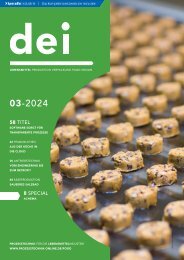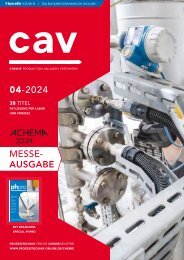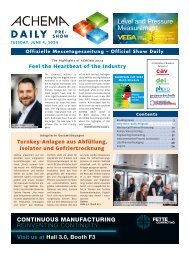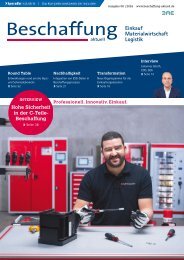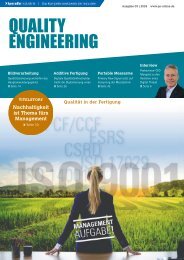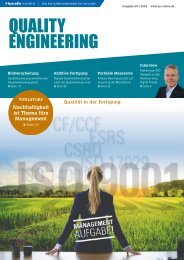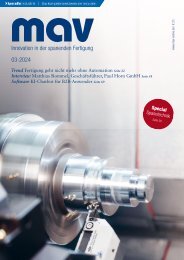cpp – Process technology for the chemical industry 01.2019
The journal cpp - Process technology for the chemical industry reports about processes, plants, apparatus and components for the chemical and pharmaceutical industry. Further topics are IT technologies, industry 4.0, digital production, MSR and automation technology and process analysis technology. The content spectrum is rounded off by explosion protection, plant safety, occupational health and safety, maintenance, site management and energy management.
The journal cpp - Process technology for the chemical industry reports about processes, plants, apparatus and components for the chemical and pharmaceutical industry. Further topics are IT technologies, industry 4.0, digital production, MSR and automation technology and process analysis technology. The content spectrum is rounded off by explosion protection, plant safety, occupational health and safety, maintenance, site management and energy management.
Create successful ePaper yourself
Turn your PDF publications into a flip-book with our unique Google optimized e-Paper software.
<strong>cpp</strong><br />
PLANTS, APPARATUS, COMPONENTS<br />
acetic acid was chosen to represent <strong>the</strong> acid<br />
class at a temperature of 98 °C. Pure methyl<br />
ethyl ketone (MEK) represented <strong>the</strong> solvent<br />
class at a temperature of 80 °C, while pure<br />
toluene at 40 °C represented <strong>the</strong> alkylbenzenes.<br />
Demanding, challenging conditions<br />
were deliberately created <strong>for</strong> <strong>the</strong> materials,<br />
with storage temperatures very close to<br />
boiling point in <strong>the</strong> first two cases. The test<br />
samples were exposed to acetic acid and<br />
MEK <strong>for</strong> three days and immersed in toluene<br />
<strong>for</strong> an entire week.<br />
Picture: Freudenberg Sealing Technologies<br />
Fig. 3: Results relating to volume changes in acetic acid, methyl ethyl keton (MEK), and toluene<br />
Results of <strong>the</strong> lab tests<br />
Changes in volume such as swelling or<br />
shrinkage give an indication whe<strong>the</strong>r a material<br />
absorbs media or gives off components.<br />
Swelling was <strong>the</strong> sole relevant criterion<br />
<strong>for</strong> <strong>the</strong> Chem XP lab tests. If swelling<br />
is not limited to a certain degree, seals can<br />
lose <strong>the</strong>ir functionality and leaks could<br />
occur. For <strong>the</strong> purposes of <strong>the</strong> tests, a maximum<br />
permissible volume change of +10 %<br />
was set. A standard FKM, <strong>the</strong> proven<br />
75 Simriz 495 and four special, highly<br />
fluorinated varieties of FKM from competitors<br />
were used <strong>for</strong> reference.<br />
As Figure 3 shows, <strong>the</strong> standard FKM material<br />
is not suited <strong>for</strong> <strong>the</strong>se demanding test<br />
conditions. Especially in acetic acid and<br />
MEK, <strong>the</strong> swelling was far too great; <strong>the</strong><br />
seals would deteriorate in <strong>the</strong> <strong>for</strong>eseeable<br />
future. The tested elastomer mixtures from<br />
manufacturers 1 and 2 exhibited clear<br />
weaknesses during <strong>the</strong> acetic acid test. The<br />
same was true of <strong>the</strong> mixtures from manufacturers<br />
2 and 3 in MEK. Only <strong>the</strong> material<br />
from manufacturer 4 could be used with<br />
certain limitations in <strong>the</strong> test conditions. In<br />
acetic acid and toluene, <strong>the</strong> Chem XP 1 variant<br />
delivered results that were comparable<br />
to <strong>the</strong> very low volume change <strong>for</strong><br />
75 Simriz 495, <strong>the</strong> FFKM material par -<br />
ticipating in <strong>the</strong> test. At temperatures below<br />
+80 °C, <strong>the</strong> material also showed outstanding<br />
stability in MEK. The Chem XP 2 variant<br />
which was tested in parallel likewise demonstrated<br />
good resistance to acetic acid and<br />
toluene, but is only limitedly suited <strong>for</strong> use<br />
in MEK at +80 °C.<br />
Standard FKM also proved to be unsuitable<br />
during <strong>the</strong> strength tests (see Figure 4). In<br />
addition to a high degree of swelling, <strong>the</strong><br />
more than 30 % reduction in strength indicates<br />
<strong>chemical</strong> breakdown of cross-linkages<br />
and polymer chains in <strong>the</strong> elastomer matrix.<br />
The materials from manufacturers 1 to 4<br />
showed an impermissible deterioration in<br />
Picture: Freudenberg Sealing Technologies<br />
Fig. 4: Results relating to strength changes in acetic acid and methyl ethyl ketone (MEK) and toluene<br />
strength in MEK, similar to <strong>the</strong> picture <strong>for</strong><br />
manufacturers 3 and 4 in toluene. This puts<br />
<strong>the</strong> moderate swelling values of manufacturer<br />
1 in MEK (Figure 3) into perspective:<br />
with an up to 60 % loss of strength, it was<br />
discarded as a potential candidate. In all<br />
cases, <strong>the</strong> strength values <strong>for</strong> Chem XP 1<br />
were within <strong>the</strong> tolerance limits and<br />
comparable to <strong>the</strong> very good values of<br />
75 Simriz 495. The excellent volume stability<br />
of Chem XP 2 in acetic acid and toluene<br />
was confirmed by <strong>the</strong> only slightly reduced<br />
strength in both cases.<br />
In summary, it can be said that <strong>the</strong> newly<br />
developed Chem XP materials rank directly<br />
below FFKM in terms of media resistance<br />
and in <strong>the</strong> future can serve as standard materials<br />
<strong>for</strong> <strong>the</strong> <strong>chemical</strong> processing <strong>industry</strong>.<br />
Lab tests confirmed that <strong>the</strong>y provide a very<br />
good balance between per<strong>for</strong>mance and<br />
cost.<br />
The first seals made from Chem XP are expected<br />
to be ready <strong>for</strong> serial production in<br />
early 2019. O-rings and <strong>for</strong>med parts are<br />
among <strong>the</strong> possible varieties of seals suited<br />
<strong>for</strong> this material. The exact material types<br />
and applications will be determined in joint<br />
tests with customers. Freudenberg’s development<br />
engineers are simultaneously working<br />
on o<strong>the</strong>r variations of <strong>the</strong> new material<br />
family.<br />
www.<strong>cpp</strong>-net.com<br />
Online search: <strong>cpp</strong>0119freudenberg<br />
AUTHOR:<br />
DR. ROBERT ROTZOLL<br />
Business Development<br />
Manager <strong>Process</strong> Industry,<br />
Freudenberg Sealing<br />
Technologies<br />
58 <strong>cpp</strong> 01-2019





